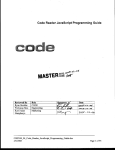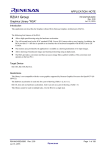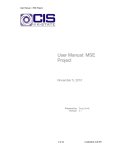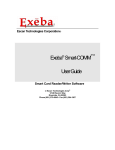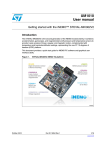Download Net Protocol Suite User-Defined Decoding (UDD
Transcript
Protocol Solutions Group
3385 Scott Blvd.
Santa Clara, CA 95054
Net Protocol Suite
User-Defined Decoding
(UDD)
Reference Manual
Manual Version 1.01
For Software Version 1.60
September 2014
Document Disclaimer
The information contained in this document has been carefully checked and is believed to be reliable.
However, no responsibility can be assumed for inaccuracies that may not have been detected.
Teledyne LeCroy reserves the right to revise the information presented in this document without notice
or penalty.
Trademarks and Servicemarks
Teledyne LeCroy is a trademark of Teledyne LeCroy.
Microsoft and Windows are registered trademarks of Microsoft Inc.
All other trademarks are property of their respective companies.
Copyright
© 2014 Teledyne LeCroy, Inc. All Rights reserved.
This document may be printed and reproduced without additional permission, but all copies should
contain this copyright notice.
ii
Table of Contents
Table of Contents ..................................................................................................................................................iii
1
Introduction................................................................................................................................................... 1
2
Supported Scripting Languages ..................................................................................................................... 1
3
Architecture................................................................................................................................................... 1
4
3.1
Theory of Operation .............................................................................................................................. 1
3.2
Decoding Flow ....................................................................................................................................... 1
Python API Reference .................................................................................................................................... 2
4.1
Modules................................................................................................................................................. 2
4.1.1
4.1.1.1
4.2
UDDEnum ...................................................................................................................................... 2
Enumerations ............................................................................................................................ 2
Classes ................................................................................................................................................... 2
4.2.1
4.2.1.1
4.2.2
4.2.2.1
4.2.3
4.2.3.1
OutContext .................................................................................................................................... 2
Members ................................................................................................................................... 2
Spec ............................................................................................................................................... 3
Methods .................................................................................................................................... 3
InputContext.................................................................................................................................. 4
Methods .................................................................................................................................... 4
4.3
Globals ................................................................................................................................................... 5
4.4
Entry Point Functions ............................................................................................................................ 5
5
Script Structure.............................................................................................................................................. 6
6
Examples........................................................................................................................................................ 6
How to Contact Teledyne LeCroy .......................................................................................................................... 7
iii
1 Introduction
This manual describes how to define a script for decoding a particular protocol for Net Protocol Suite using
User-Defined Decoding (UDD). You can define the format of protocols by introducing fields and their
attributes: Name, Abbreviation, Description, MSB order and Byte Alignment. Additionally, you can decode a
specific field by adding the options.
The scripts themselves are written in standard scripting languages and use a special Extension API to
communicate with the Net Protocol Suite application.
2 Supported Scripting Languages
Python 2.7.x
3 Architecture
3.1 Theory of Operation
When a trace file is opened by the application, all frames inside the trace will first be decoded by the built-in
decoder services. UDD allows you to extend and modify the built-in decoding services to your own
definitions and concepts by creating custom decoding scripts, which have the file extension “.udd” and may
be stored anywhere on your system. Once a script is created, it must then be assigned to a Protocol Type
that exists in the trace file to be decoded. By doing this, the application communicates with your defined
and assigned scripts for Protocol Types, initializes the fields and options, decodes the packets related to that
specific protocol types, and change the packets structure in the GUI at the end.
Note: Refer to the Decoding Assignments section of the Net Protocol Suite User Manual for details on how
to assign a script decoder for a protocol.
3.2 Decoding Flow
User
Application
1 : Assign a Script Decoder for a protocol()
Script Decoder
2 : OnInitialize()
foreach Field
3 : DefineField()
while more packets
4 : Scroll through trace view()
5 : PreparePacketForDecoding()
6 : OnDecode()
foreach Field
7 : AddField()
8 : DisplayPacket()
Figure 1. High-Level Script Decoding Sequence.
Figure 1 shows a high-level script decoding sequence. It shows that upon being assigned to a protocol in a
trace file, a script decoder’s OnInitialize function is called to define the set of fields (e.g., via
DefineField) that will be handled by the script. Then, when a packet/frame from the trace file needs to
be decoded, the application prepares the raw data and sends it to the script decoder through the
OnDecode function, which will add the decoded fields (e.g., via AddField) to the packet/frame.
1
The entry point functions, OnInitialize and OnDecode, must be implemented in the script by the
user. See section 4.4 for details on these functions.
4 Python API Reference
4.1 Modules
4.1.1 UDDEnum
In order to use the mandatory built-in enumerations, the script must import UDDEnum Python module.
4.1.1.1
Enumerations
BitOrder
This enumeration represents the Bit Order of a field.
Value
MSB
LSB
Description
Most-significant bit first.
Least-significant bit first.
ByteOrder
This enumeration represents the Byte order of a multi-byte field.
Value
RIGHT_ALIGNED
LEFT_ALIGNED
Description
Little endian.
Big endian.
4.2 Classes
4.2.1 OutContext
This class is a singleton and may not be instantiated in the script. The single instance is called “out”, which
may be used by the OnDecode function to communicate special decoding results back to the application.
4.2.1.1 Members
Result
If this member is set to 1 by the OnDecode function, then any decoded fields added will be kept;
otherwise, any decoded fields will be rolled back.
2
4.2.2 Spec
This class represents the static field definitions of a protocol’s message formats.
4.2.2.1 Methods
DefineField(name, abbreviation, tooltip, bit_order, byte_order)
Defines a new field or updates an existing field.
Parameter
name
abbreviation
tooltip
bit_order
Type
string
string
string
BitOrder
Default Value
byte_order
ByteOrder
return value
int
ByteOrder.
LEFT_ALIGNED
1 - success
0 - error
BitOrder.MSB
Description
Name of the field to be defined.
Abbreviation of the field to be defined.
Tooltip of the field to be defined.
The Bit Order of the field to be
defined.
The Byte Order of the field to be
defined.
DefineFieldDecode(name, decode_value, length, decode_name,
decode_description)
Define a custom decoding for an existing field. This decoding may override the application’s builtin decoding for a field.
Parameter
name
decode_value
length
decode_name
decode_description
return value
Type
string
unsigned
int
int
string
string
int
Default Value
Description
Name of the field to be decoded.
Value of the field to be decoded.
Length in bits of the field
The new name of decoded field.
The description of decoded field.
1 - success
0 - error
RenameField(name, new_name)
Change an existing field name to a new name.
Parameter
name
new_name
return value
Type
string
string
int
Default Value
1 - success
0 - error
3
Description
Name of the field to rename.
New name of the field.
4.2.3 InputContext
This class represents the packet/frame to be decoded. It provides access to the raw data, and it is the
container for any decoded fields that are added.
4.2.3.1
Methods
AddField(name, length, parent_id)
Adds a field to the current packet being decoded.
Parameter
name
length
parent_id
Type
string
int
list
return value
list
Default Value
Description
Name of the field to rename.
The length in bits of the field.
null
The identifier of Parent's field. If
‘null’, then the field has no parent.
If a field has been successfully added to a Packet, its
identifier will be returned as the return value.
GetFieldData(field_id, start_pos, length)
Retrieves data from a field.
Parameter
field_id
start_pos
length
Type
list
unsigned
int
int
return value
list
Default Value
Description
The field identifier.
The start position value inside a
field.
The data length in bits to retrieve
from the field.
A buffer list of Bytes retrieved data from a field.
GetData(start_pos, length)
Retrieves data from a raw packet.
Parameter
start_pos
length
Type
unsigned
int
int
return value
list
Default Value
Description
The start position value in the
packet.
The data length in bits to retrieve
from the field.
A buffer list of Bytes retrieved data from a field.
4
4.3 Globals
OutContext out
The "out" singleton needs to be used inside the OnDecode function. If you confirmed the
changes of decoding in the script, then out.Result must set to 1; otherwise, the decoding will
not be applied.
4.4 Entry Point Functions
OnInitialize(spec)
This function must be defined in the decoding script. It allows you to initialize, define, and rename
the fields for an existing built-in decoder or a custom script decoder. The application calls this
function to initialize the Spec object that represents the protocol decoded by the script. In this
function, the script must define the fields handled by the script by adding them to the Spec object.
If you make any modifications on the fields definitions for a defined and assigned protocol type in
the trace, then application just calls this function once to reorganize the structure of the fields. This
function has one parameter named "spec" which is the interface to communicate with application
for initialization of the user-defined fields’ declarations and definitions.
Parameter
spec
Type
Spec
return value
none
Default Value
Description
The Spec object that represents the
protocol decoded by the script.
OnDecode(incontext)
This function must be defined in the decoding script. The application calls this function for each
packet to be decoded. This function provides one parameter named "incontext" as an interface
between application and your script. This parameter allows you to use your already defined fields
from the OnInitialize function, add them to the packet and fetch the data from a field or
packet in order to support your decoding procedure.
If you set “out.Result = 1” and then return from the function, then the decoded fields will be
applied; otherwise, they will be rolled back.
Parameter
incontext
Type
InputContext
return value
none
Default Value
5
Description
The Spec object that represents the
protocol decoded by the script.
5 Script Structure
from UDDEnum import *
def OnInitialize (spec):
# Initialize the Fields
def OnDecode (incontext):
# Do the Decoding
out.Result = 1
6 Examples
from UDDEnum import *
def OnInitialize(spec):
spec.DefineField("Field", "Field Abbrev", "Field Tip", BitOrder.MSB, ByteOrder.LEFT_ALIGNED)
spec.DefineField("Field 1", "Field1 Abbreviation", "Field1 Tooltip")
spec.DefineField("Field 3", "Field3 Abbreviation", "Field3 Tooltip")
spec.DefineField("Field 4", "Field4 Abbreviation", "Field4 Tooltip")
spec.DefineField("Field 5", "Field5 Abbreviation", "Field5 Tooltip")
spec.DefineField("Field 6", "Field6 Abbreviation", "Field6 Tooltip")
spec.RenameField("Field 1","Field 2")
spec.RenameField("Field 2","Field 1")
spec.DefineFieldDecode("Field 3",0x04D2,16 ,"Option 1", "Option1 Description")
spec.DefineFieldDecode("Field 3",0x05D2,16 ,"Option 2", "Option2 Description")
def OnDecode(incontext):
fieldId = incontext.AddField("Field", 32)
fieldId1 = incontext.AddField("Field 1", 32)
fieldId2 = incontext.AddField("Field 3", 16)
fieldId3 = incontext.AddField("Field 4", 8,fieldId2)
fieldId4 = incontext.AddField("Field 5", 8,fieldId2)
incontext.AddField("Field 6", 32)
fieldData = incontext.GetFieldData(fieldId1,0,32)
fieldbufferlength = len(fieldData)
fieldoutfile = open("c:/temp/FieldFilePython", "wb")
for i in range(0,fieldbufferlength):
fieldoutfile.write("%x\n" % fieldData[i])
fieldoutfile.close()
if len(fieldData) != 0 :
if fieldData[0] == 0x28 :
frameData = incontext.GetData(64, 64)
framebufferLength = len(frameData)
outFile = open("c:/temp/FrameFilePython", "wb")
for i in range(0,framebufferLength):
outFile.write("%x\n" % frameData[i])
outFile.close()
out.Result = 1
6
How to Contact Teledyne LeCroy
Type of Service
Call for technical support…
Fax your questions…
Write a letter …
Send e-mail…
Visit Teledyne LeCroy web site…
Contract
US and Canada:
1 (800) 909-2282
Worldwide:
1 (408) 727-6600
Worldwide:
1 (408) 727-6622
Teledyne LeCroy
Customer Support
3385 Scott Blvd.
Santa Clara, CA 95054
[email protected]
teledynelecroy.com/
7










